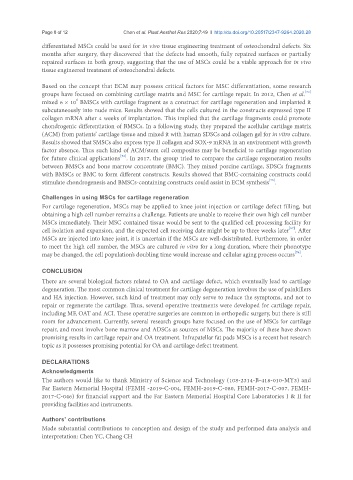Page 570 - Read Online
P. 570
Page 8 of 12 Chen et al. Plast Aesthet Res 2020;7:49 I http://dx.doi.org/10.20517/2347-9264.2020.28
differentiated MSCs could be used for in vivo tissue engineering treatment of osteochondral defects. Six
months after surgery, they discovered that the defects had smooth, fully repaired surfaces or partially
repaired surfaces in both group, suggesting that the use of MSCs could be a viable approach for in vivo
tissue engineered treatment of osteochondral defects.
Based on the concept that ECM may possess critical factors for MSC differentiation, some research
[73]
groups have focused on combining cartilage matrix and MSC for cartilage repair. In 2012, Chen et al.
6
mixed 6 × 10 BMSCs with cartilage fragment as a construct for cartilage regeneration and implanted it
subcutaneously into nude mice. Results showed that the cells cultured in the constructs expressed type II
collagen mRNA after 4 weeks of implantation. This implied that the cartilage fragments could promote
chondrogenic differentiation of BMSCs. In a following study, they prepared the acellular cartilage matrix
(ACM) from patients’ cartilage tissue and mixed it with human SDSCs and collagen gel for in vitro culture.
Results showed that SMSCs also express type II collagen and SOX-9 mRNA in an environment with growth
factor absence. Thus such kind of ACM/stem cell composites may be beneficial to cartilage regeneration
[74]
for future clinical applications . In 2017, the group tried to compare the cartilage regeneration results
between BMSCs and bone marrow concentrate (BMC). They mixed porcine cartilage, SDSCs fragments
with BMSCs or BMC to form different constructs. Results showed that BMC-containing constructs could
[75]
stimulate chondrogenesis and BMSCs-containing constructs could assist in ECM synthesis .
Challenges in using MSCs for cartilage regeneration
For cartilage regeneration, MSCs may be applied to knee joint injection or cartilage defect filling, but
obtaining a high cell number remains a challenge. Patients are unable to receive their own high cell number
MSCs immediately. Their MSC contained tissue would be sent to the qualified cell processing facility for
[57]
cell isolation and expansion, and the expected cell receiving date might be up to three weeks later . After
MSCs are injected into knee joint, it is uncertain if the MSCs are well-dsistributed. Furthermore, in order
to meet the high cell number, the MSCs are cultured in vitro for a long duration, where their phonotype
[76]
may be changed, the cell population’s doubling time would increase and cellular aging process occurs .
CONCLUSION
There are several biological factors related to OA and cartilage defect, which eventually lead to cartilage
degeneration. The most common clinical treatment for cartilage degeneration involves the use of painkillers
and HA injection. However, such kind of treatment may only serve to reduce the symptoms, and not to
repair or regenerate the cartilage. Thus, several operative treatments were developed for cartilage repair,
including MF, OAT and ACI. These operative surgeries are common in orthopedic surgery, but there is still
room for advancement. Currently, several research groups have focused on the use of MSCs for cartilage
repair, and most involve bone marrow and ADSCs as sources of MSCs. The majority of these have shown
promising results in cartilage repair and OA treatment. Infrapatellar fat pads MSCs is a recent hot research
topic as it possesses promising potential for OA and cartilage defect treatment.
DECLARATIONS
Acknowledgments
The authors would like to thank Ministry of Science and Technology (108-2314-B-418-010-MY3) and
Far Eastern Memorial Hospital (FEMH -2019-C-004, FEMH-2019-C-080, FEMH-2017-C-007, FEMH-
2017-C-046) for financial support and the Far Eastern Memorial Hospital Core Laboratories I & II for
providing facilities and instruments.
Authors’ contributions
Made substantial contributions to conception and design of the study and performed data analysis and
interpretation: Chen YC, Chang CH

